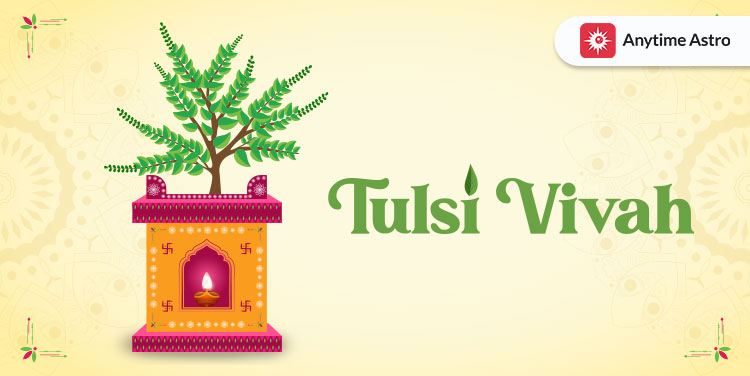In Hindu culture, Tulsi is considered a sacred plant that is also known as Holy Basil. Traditionally, Tulsi has been considered a symbol of purity, possesses excellent medicinal properties, and is found in many Hindu homes. Tulsi Puja is vital in the Hindu religion. There is great fanfare throughout the country when Tulsi is regarded as an incarnation of Goddess Lakshmi. Tulsi Vivah is a mythical marriage ceremony of Tulsi and Lord Vishnu’s incarnation, Shri Krishna.
If you wish to know about the significance and date of Tulsi Vivah then you must give this blog a read.
Tulsi Vivah Date
As per the Hindu Calendar, Tulsi Vivah is observed on the 12th day of Shukla Paksha in the Kartik month. However, any time period between Ekadashi of Prabodhini to Kartik Poornima is considered the best for the ceremony. In some regions, this festival is celebrated for approximately 5 days. The Tulsi Vivah ceremony marks the end of the Monsoon season and the beginning of Hindu wedding ceremonies. The date of the Tulsi Vivah ceremony can vary from region to region. However, in 2025, this festival will be celebrated on Sunday, November 2, 2025
Know About: Today's Hora Timings
Significance of Tulsi Vivah
Tulsi Vivah holds significant importance in the Hindu religion. According to the Hindu scriptures Tulsi is believed to be an incarnation of Laxmi maa. And she was thus married to Lord Vishnu’s incarnation, Shree Krishna or Shaligram on Prabodhini Ekadashi. Lord Vishnu, the preserver, and protector in the Hindu trinity, is believed to reside where Tulsi is present. Thus, the marriage of Tulsi with Vishnu is a symbolic representation of the divine union between a devotee (Tulsi) and the deity (Vishnu), emphasizing the importance of unwavering devotion and surrender to God.
Moreover, in India married women perform the rituals of Tulsi Vivah for their family and husband’s well-being. Since Tulsi is Goddess Mahalakshmi's avatar, young females worship them to seek marital bliss. Additionally, they offer prayers to find a good husband. As a result of this, many couples tend to schedule their marriage during the Tulsi Vivah in order to have a healthy and long-lasting relationship.

Know About Shubh Choghadiya Muhurat for Tulsi Vivah
Tulsi Vivah Story
The Tulsi Vivah story is backed by the previous birth of Tulsi. In her former birth, Tulsi was known as Vrinda. She was an ardent devotee of Lord Vishnu and the wife of a demon named King Jalandhar. Brahma ji blessed the demon with immortality provided that Vrinda remained chaste and virtuous. Due to this blessing, Jalandhar became powerful and no one could defeat him. He was so proud of his power that he once defeated Lord Shiva and started harassing the Apsaras of heaven. His act created a feeling of terror and fear among all the Gods.
Unable to find any solutions, the Gods then sought help from the Lord Vishnu. On the request of the deities, Lord Vishnu disguised himself as the demon Jalandhar and destroyed Vrinda’s virtuous dharma through treachery. Consequently, the demon was no longer powerful and was killed in a battle. After learning the truth about Lord Vishnu's deceitful act, she cursed Lord Vishnu stating that he would turn into a black stone known as Shaligram. Vrinda was also cursed to turn into a Tulsi plant later. Later Vrinda withdrew her curse at the request of the devotees. Lord Vishnu was hurt by his actions and thus vowed to marry Tulsi in the form of Shaligram every year.
Today Rahukaal Timing
Tulsi Vivah Ritual
The marriage of Lord Krishna and Tulsi is similar to any other Hindu marriage. Majorly the ceremony takes place in the temples but it can also be held at home. People conducting Tulsi Vivah must observe fast after the commencement of the ceremony till the evening. Tulsi Vivah rituals start with giving a holy bath to the Tulsi plant as well as Lord Vishnu’s idol. A beautiful mandap surrounding the Tulsi planet is made through sugarcane talks, followed by the colorful Rangoli. Moreover, the holy plant Tulsi is dressed up in a brightly colored saree just like any other Indian bride. Turmeric and Vermillion powder is also offered to the Tulsi plant.
On the other side, The Shaligram stone, or Lord Vishnu’s brass idol is draped with a traditional dhoti. Further, Lord Vishnu and Tulsi are linked through a thread for the commencement of the ceremony. The Tulsi Vivah can be performed by either a priest or a group of women. Devotees shower the couple with rice and vermillion powder. This marks the completion of the ceremony. Subsequently, the bhog or prasad is distributed among the people present during the Tulsi Vivah.
Know About: Today Gowri Panchangam
In the region of Saurashtra, this festival is celebrated lavishly by exchanging wedding cards between the groom’s temple and the bride’s temple. The ceremony takes place in the two Rama temples. The wedding procession is carried out from the God Vishnu’s temple to Tulsi Ma’s temple. Villagers of the latter’s temple welcome the baraat and conclude it with bhajans, followed by the Tulsi aarti.
Every region has its own way of celebrating this festival. In some regions, all the expenses related to the ceremony are borne by couples who are unable to conceive or do not have a daughter. Kanyadaan of goddess Tulsi is also performed by these couples on this occasion. It is believed that people performing kanyadaan are soon blessed with a child.
Also See: Today Horoscope Free
Concluding Lines…
This blog was all about the significance and rituals of Tulsi Vivah. In the Hindu religion, the Tulsi Vivah celebrates the union between Lord Vishnu and the Tulsi plant. Typically, the festival occurs in October or November, marking the beginning of the Indian wedding season. To know in detail about the significance of Tulsi Vivah, You can always consult an expert Astrologer. They have in-depth knowledge and can also tell you the benefits of Tusli puja, Vivah, and much more.





Leave a Comment